Pet blogging is one of our favorite niches.
Why? Because pet owners love their furry, feathery, or scaly friends. They’d do pretty much anything to make them happy. And that includes spending a bunch of money on them.
Figures show that pet lovers in the US spend an average of $1,201 per year on dogs and $687 per year on cats.
As that graphic demonstrates, there are myriad ways to spend money on pets, from pet food, vaccinations, and insurance, to luxuries like grooming, training, and accessories.
That means there are lots of opportunities within the pet industry, which means there are plenty of reasons to start a pet blog.
Read on, and we’ll look at:
- Why it makes sense to start a pet blog
- What a successful blog looks like in the pet niche
- How to start pet blogging in nine easy-to-follow steps
- How to make more money from your brand new blog
- How much money you can earn as a pet blogger
Why Start a Pet Blog
Make Money From Your Love Of Pets
Let’s start with the most obvious point:
If you start your own blog, you’ve got the chance to make money online by promoting a bunch of pet-friendly products and services, all while writing about a subject you love.
That’s a pretty sweet gig, right?
Of course, you’re not going to earn a full-time income from day one. It’ll likely be months before you start seeing a return.
But lots of website owners earn money from their hobbies. If you put the work in, there’s no reason why you can’t join them.
Promote Your Pet Business
Lots of people have started blogging to raise the profile of their existing businesses, and the pet industry is no different.
From dog walkers to cat groomers to parrot elocution tutors, all types of pet businesses can benefit from a little blog-based promotion.
Starting a blog can help you generate more website traffic through search engine optimization.
Just find some relevant keywords, create content to target them, and hey preto — you get more traffic to your site.
And more traffic means more leads and sales.
Not only that, but pet blogging gives you another avenue to make money online from your website.
If you run a pet business, you’re likely using a bunch of pet products already.
So why not join an affiliate program or two, then promote those products to your target audience?
Every time someone clicks your affiliate link and makes a purchase, you earn a commission.

Build a Community
Of course, pet bloggers aren’t just in it for the money.
Whether you’re a dog lover, a cat parent, or a pigeon fancier (look it up — they exist), the biggest motivation to start your own pet blog is likely the fact that you love pets.
And so do lots of other pet owners.
Having a pet blog can be a fantastic way to build a like-minded community of fellow pet fanatics who can support one another with advice on things like pet health and training.
You could even use it to promote and raise money for your favorite pet charities.
Examples Of The Best Pet Blogs
It makes sense to do a little competitor research before starting your pet blogging journey.
With that in mind, we’ve rounded up three successful blog examples from the pet niche and taken a look at what makes them tick:
Walkin’ Pets Blog
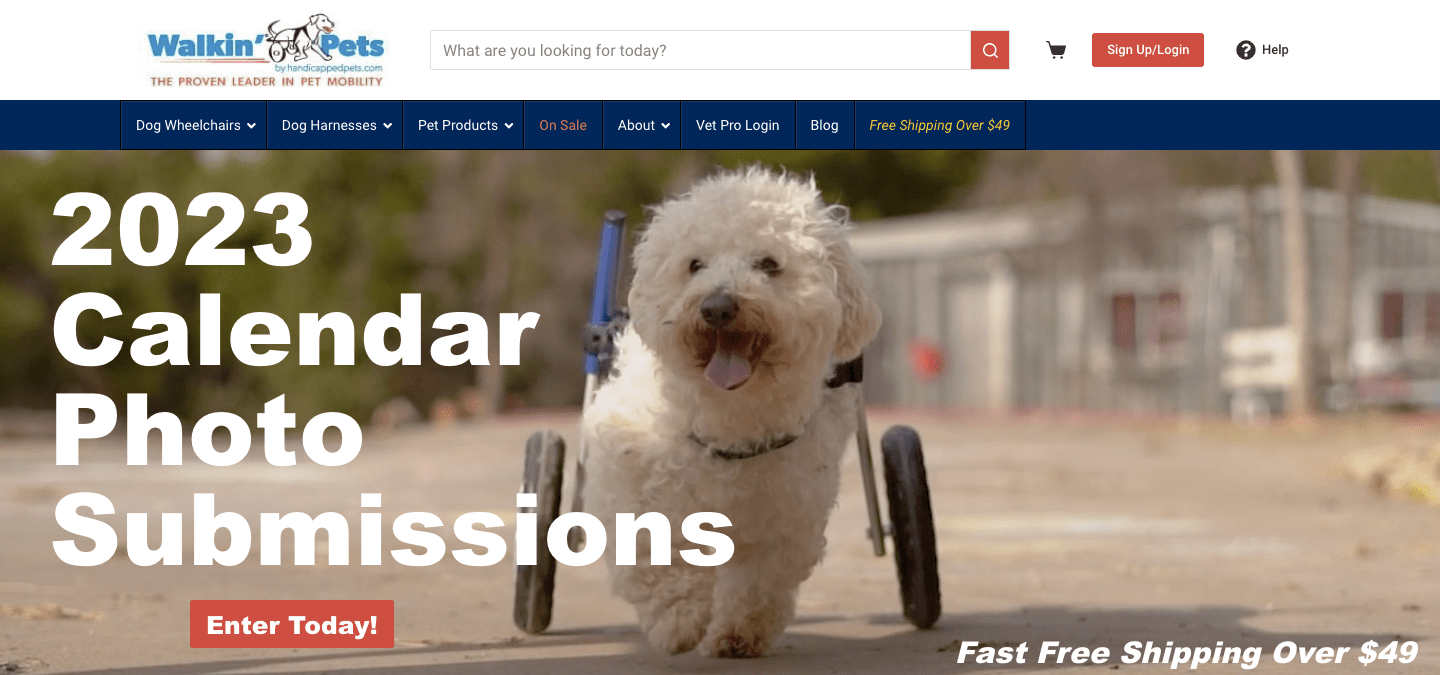
The Walkin’ Pets blog is run by Handicapped Pets, which sells equipment for dogs, cats, and other animals with physical disabilities.
Unsurprisingly, the blog itself is geared toward educating owners of disabled pets, such as explaining the practicalities of dog hip braces.
Many of its pet blog posts incorporate calls to action for specific products that are sold via the Handicapped Pets online store.
However, Walkin’ Pets also publishes lots of community-related content, often aimed at finding a new home for disabled rescue dogs and cats.
Dog Food Advisor
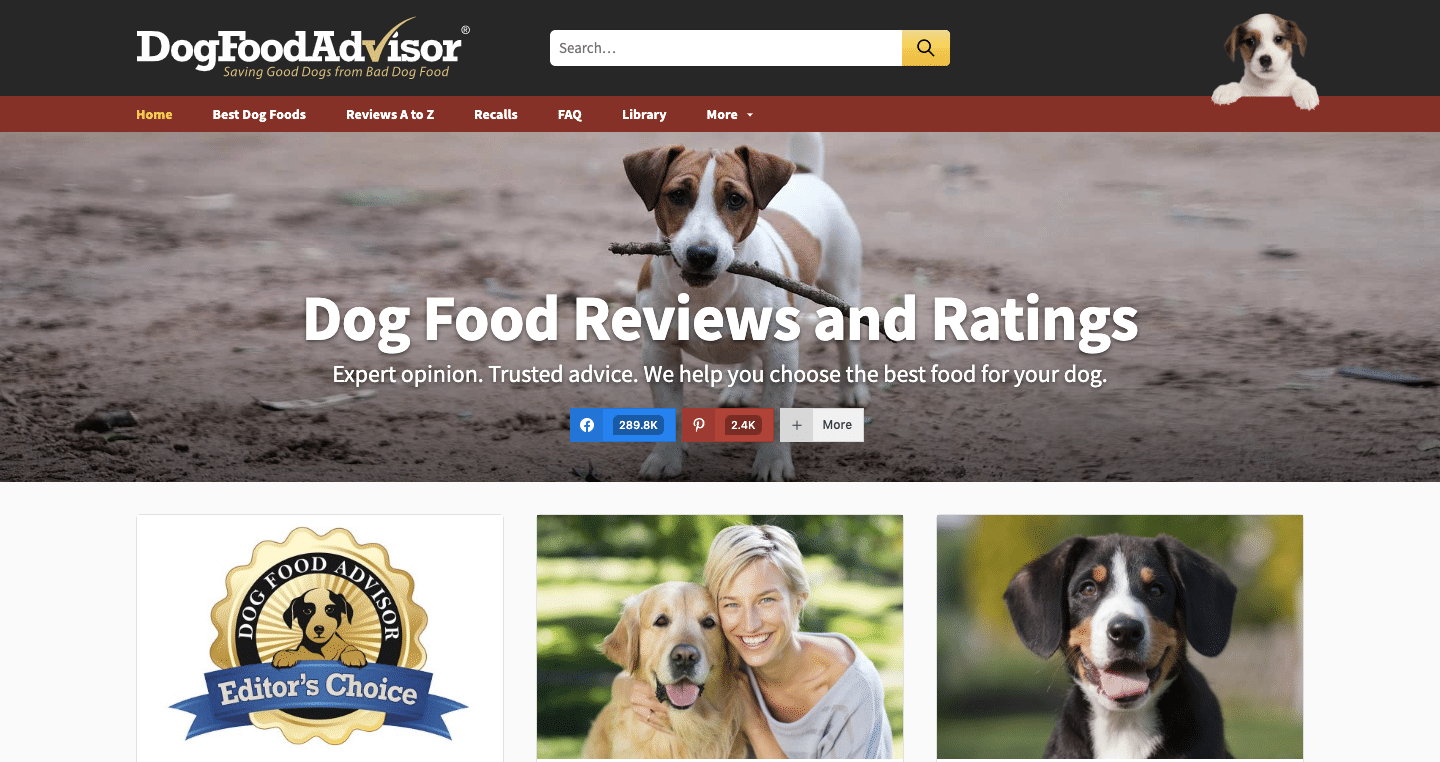
Dog Food Advisor is a classic example of an authority site in the pet industry.
By honing in on a specific niche and creating a wealth of high-quality content, it’s built a valuable resource for dog owners that brings in more than one million organic visitors a month:

The site publishes a wealth of informational blog content covering important topics like the harmful toxins to avoid in dog foods and the best ways to identify quality pet food brands.
However, its real meat and drink (no pun intended) is around commercial content identifying the best dog food brands across multiple sub-niches — such as the best raw dog foods and the best foods for small dogs.
GoPetFriendly

GoPetFriendly describes itself as America’s “fastest-growing pet-friendly travel planning platform,” with its audience using the site to plan hundreds of thousands of outdoor adventures every year.
As you can imagine, its blog focuses on providing pet travel tips, like the best locations to visit with dogs, or road trip ideas for pet owners.
Just like Dog Food Advisor, a lot of this content is monetized through affiliate marketing. For instance, its article on the best GPS dog trackers features affiliate links to products on Amazon and has its own Amazon store.
GoPetFriendly also sells advertising space on its site via the Mediavine ad network.
Catster
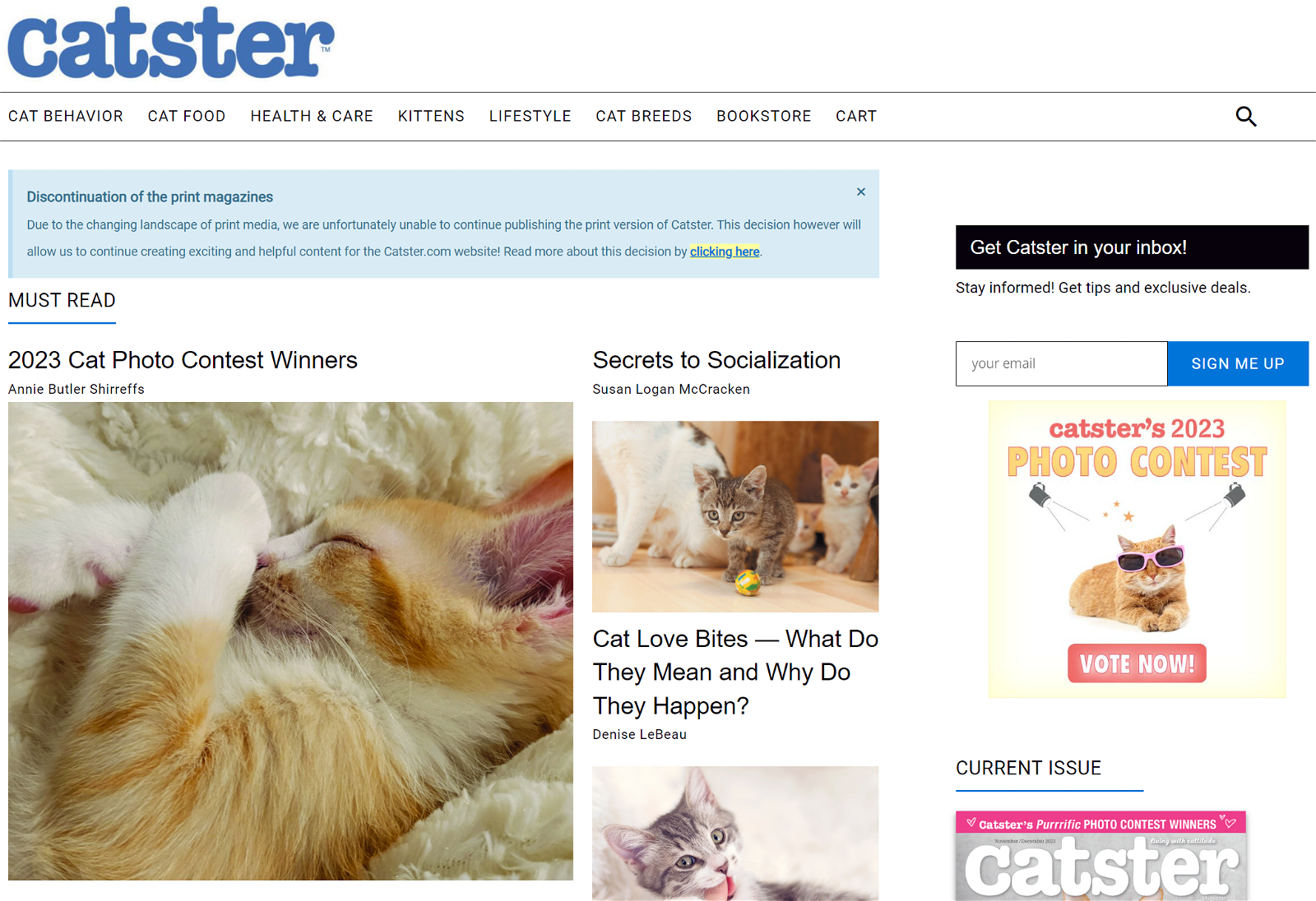
Catster is the online version of the longest-running print publication for cat lovers. Although it recently discontinued its print magazine, the website continues to offer top-tier advice on cat health, food, behavior, and more.
They also have an extensive glossary of cat breeds that readers can use to identify and learn more about their pet cats.
The blog is monetized with display ads through Raptive. Their navigation menu also has links to a bookstore, but it doesn’t appear to be live yet.
9 Steps to Start a Pet Blog
We’ve covered the reasons for starting a pet blog and looked at a few real-world examples of folks who are already doing it.
Now, we’re going to spell out nine simple steps to help you launch your own pet blog without requiring a huge budget or tons of technical skills.
1 Narrow Down a Pet Blogging Niche
Each pet blog we included in the previous section brings in at least 100,000 visitors a month.
What makes them so successful?
Well, lots of things. A bunch of hard work, clever keyword research, a smart promotion strategy…
But most of all, its because the website owners identified a strong niche.
Rather than starting a generalist cat or dog blog, they honed in on a specific subcategory within the wider pet world — like caring for disabled pets, traveling with pets, and choosing the best dog food.
This approach has huge benefits: it allows you to tap into a ready-made audience while also helping you generate website traffic without competing with huge, well-established sites.
So how do you choose the right niche?
Start by defining your target audience. They could be:
- People planning to adopt their first pet
- Pet owners searching for pet health advice
- People who want information about specific pet breeds
- Owners who want to understand their pet’s behavior
- Dog owners looking for training tips
Ideally, you’ll have some interest and/or expertise in your chosen pet niche. But it’s not essential, and you certainly don’t need to be a trained professional. Most bloggers simply write about their learnings and experiences from having their own pets.
With a bit of luck, you’ll have a bunch of potential ideas by this point. Some (or all) of them will likely be pretty vague, so now it’s time to flesh them out into something more specific, like:
- An informational resource on which breed of dog or cat you should adopt
- A review site recommending must-have products for first-time pet parents
- A site offering pet health advice for people with older pets
Hopefully, you get the idea.
But what if you’re not feeling too creative? What if the perfect niche is eluding you?
Don’t worry; we’ve got a couple of practical steps you can take.
The first involves using our favorite SEO tool, Ahrefs (N.B. check out our Ahrefs review to see why we love it so much). It’s not free, but in our opinion, it’s worth every cent.
With Ahrefs, you can enter one of your fav pet blogs — say, Dog Food Advisor — then use the Competing Domains tool to find sites ranking for similar keywords:
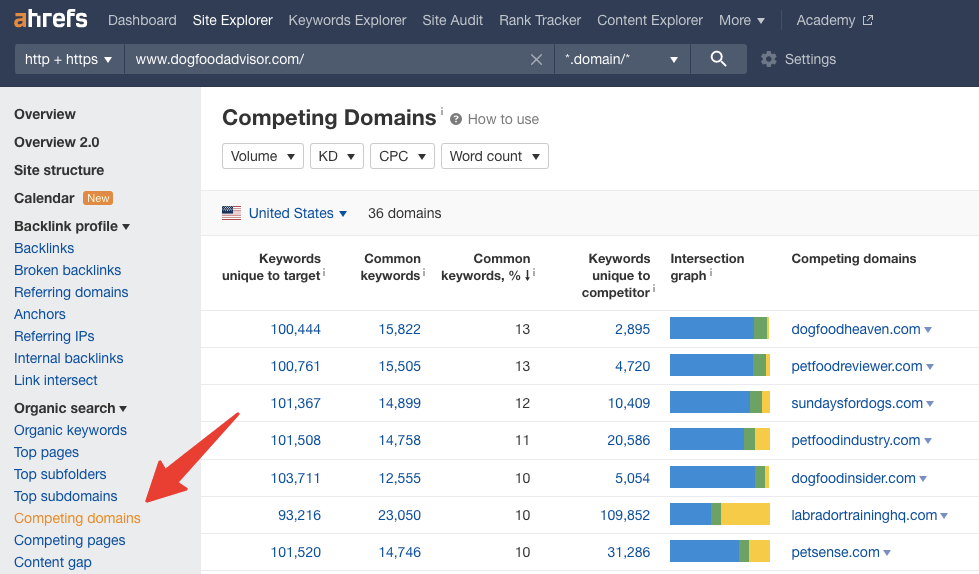
A lot of those sites will be in different niches to your “seed” website, so click through them, see what they’re doing, and use it as inspiration for your own blog.
Alternatively, use the FeedSpot database to find dozens of successful pet blogs, along with useful information about their social followings and blog post publishing frequency.
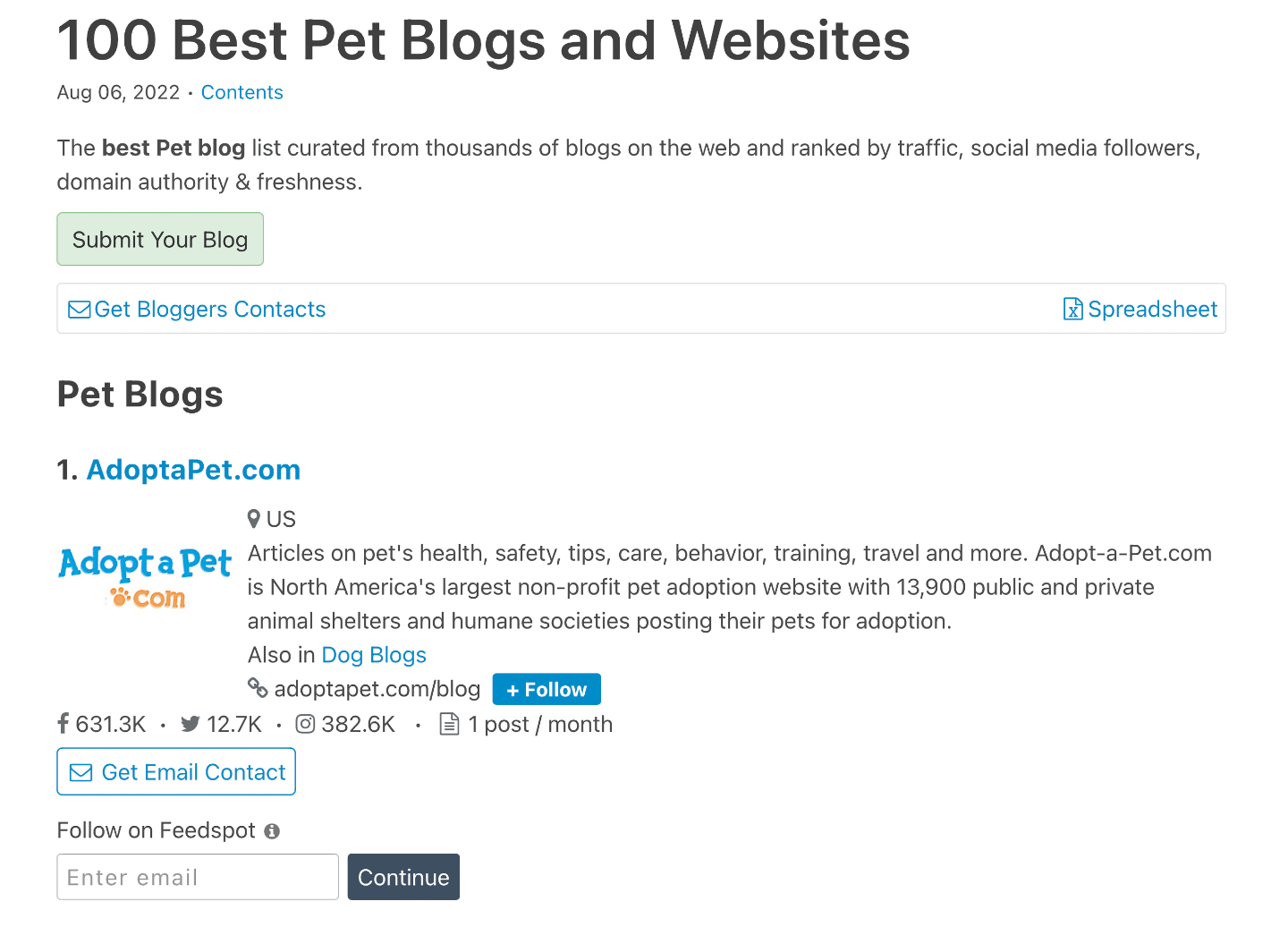
Again, the more pet blogs you look at, the more inspiration you’ll find for your new site.
2 Choose a Blogging Platform
Blogging doesn’t necessarily mean starting your own website.
There are plenty of pet blogs on free blogging platforms like Blogger and Medium. In a lot of ways, those platforms are more convenient (and cheaper) than building a new site from scratch.
Similarly, you might not want to start a traditional, written blog at all. Why bother when there are so many influencers and vloggers finding success on Instagram and YouTube?
Those are all good points (that’s why we made them). But trust us: creating your own website is a much better option.
Why?
Because it gives you a ton of routes to promote your pet blog and grow your audience, such as:
- Building a mailing list and promoting your latest blog post via email marketing
- Creating multiple social media profiles to point visitors toward one website: your pet blog
- Using SEO to generate traffic from search engines
And it also gives you a ton of control over how your site looks, allowing you to create a recognizable brand that separates you from the competition and keeps your audience coming back for more.
Okay, so starting a website is the best way to get your blog set up. But which platform should you choose?
As far as we’re concerned, there’s one clear winner: WordPress.org.
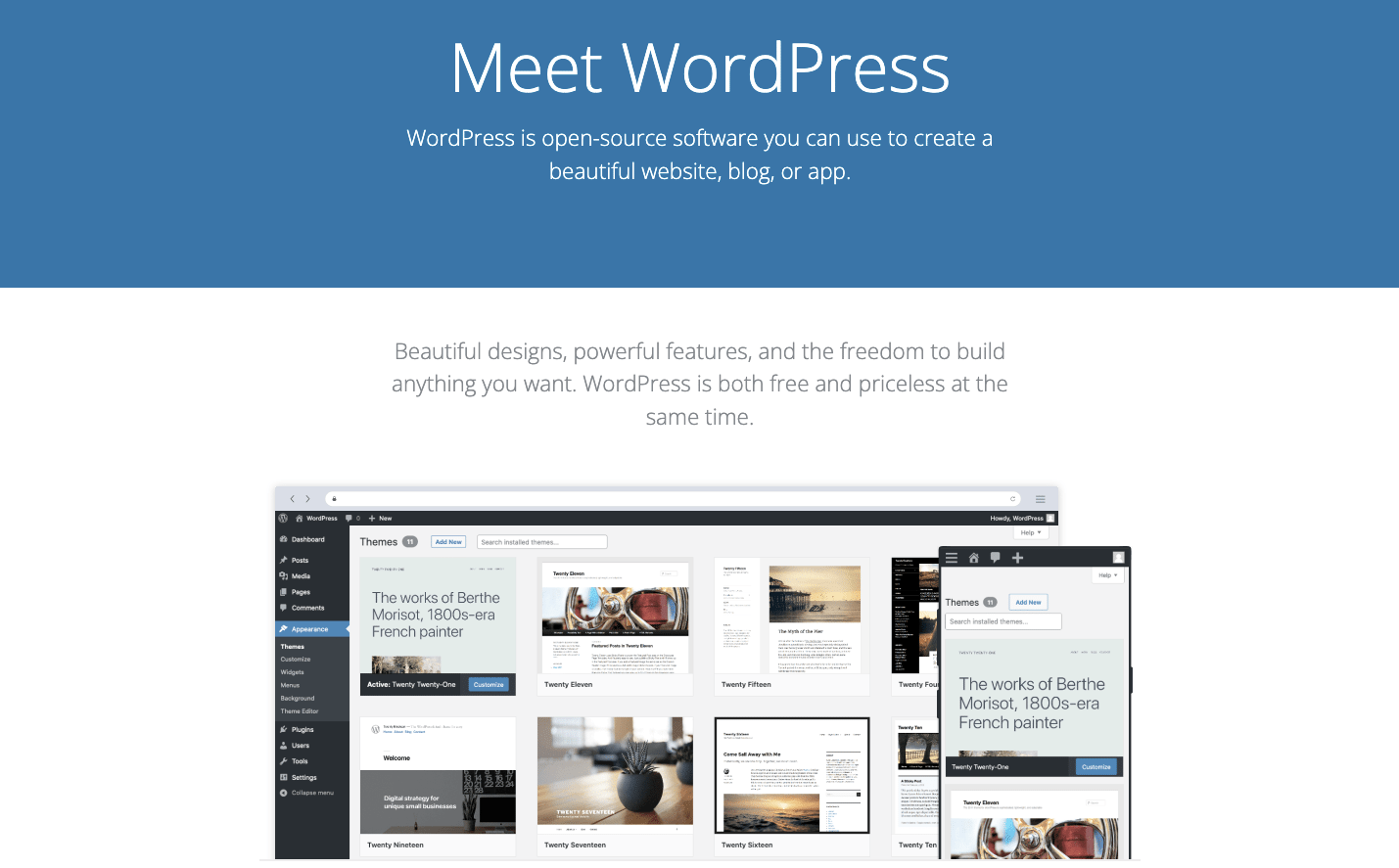
There are many reasons to choose WordPress.org as your blogging platform. For instance:
- It’s cheap
- It comes with hundreds of free themes…
- …Which can be easily personalized to help your pet blog stand out from the crowd
- You get your choice of domain names
- It’s easy to use, with no real technical skills required
- There are lots of monetization options: ad networks, affiliate marketing, sponsorship deals, eCommerce
- Every blog post you publish belongs to you
- You can access tons of plugins to further customize and improve your new blog
3 Pick a Domain Name
Now it’s time to make your first — and arguably most important — branding-related decision: choosing the name of your pet blog.
If you’ve followed our advice and gone with WordPress.org, you won’t get a free domain name, but it definitely won’t be expensive; you’re looking at around $12 a year.
Deciding on a blog name can be intimidating. Oftentimes, it’ll be the first thing anyone notices about your site.
If, like me, you still use the email address you set up as a 15-year-old, you’ll know that picking a terrible name can have long-term consequences that require constant explanations (in my defence, [email protected] seemed like a good idea at the time).
Clearly, we can’t tell you exactly what to call your pet blog, because you’re not the only person who’s going to read this article. But we can give you some solid advice based on our extensive experience of launching (and naming) websites across multiple niches.
First, use the Instant Domain Search tool to find ideas for potential domain names in your niche:
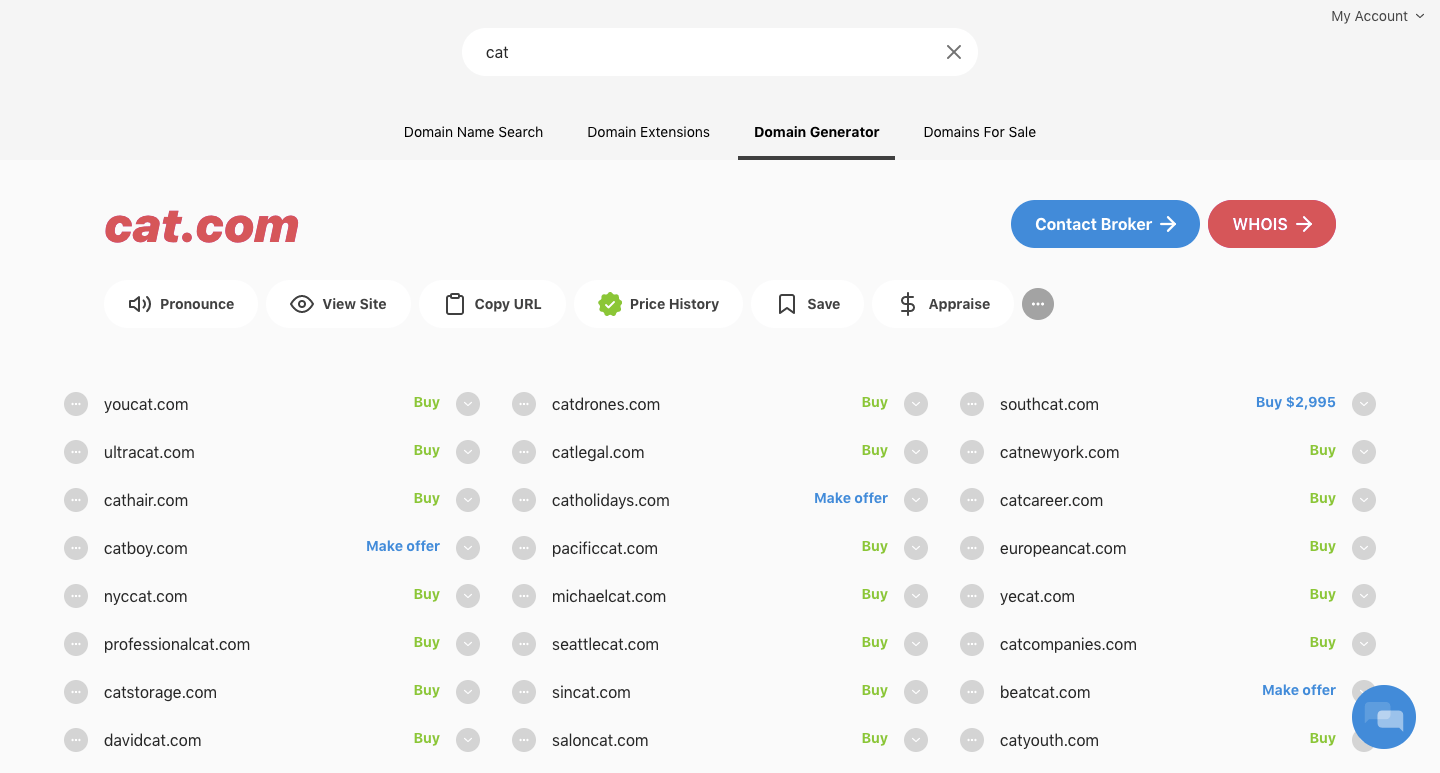
And second, follow these best practices to pick a domain name that speaks to who you are and what you do:
Pick a .com domain. Research suggests 70% of people don’t trust funky new domain suffixes like “.biz” and “.eu”, so stick with the classics.
Choose a name that matches your niche. Your domain name should spell out what your site is all about. So trainingcanines.com would be a good, clear name for a dog training blog, but felinefine.com doesn’t necessarily work for a cat grooming blog.
Give yourself some wiggle room. If you choose a domain name that’s too niche, it won’t give you scope to expand or target new audiences down the line. For instance, travelingwithpets.com gives you broader reach than travelingwithtabbies.com.
Make use of synonyms. With almost two billion websites online today, there’s a good chance your favored pet blog name will be taken. So don’t be afraid to experiment with synonyms, like “canines”, “hounds”, or even the accursed “puppers” rather than plain old “dogs”.
Keep it short and sweet. Short blog names are easier to remember, so try to keep it to 2 – 3 words.
And last but not least, don’t choose your own name.
Because unless you’re already a big name in the pet niche (or a bona fide celebrity), no one knows or cares who you are.
Also, it doesn’t reveal anything about the contents of your pet blog.
You can also use Brandsnap, our new free tool, to brainstorm domain name ideas. It’s powered by AI and can come up with amazing, memorable domain names for your pet site in a matter of seconds.
4 Buy Your Domain & Web Hosting
Buckle up, because things are about to get a little technical. It’s nothing you can’t cope with, though. We believe in you, slugger!
Buying a domain name and choosing a web hosting provider is a big step. Without it, no one’s ever going to see your pet blog, because it won’t exist (apart from in your imagination).
Your first step is to choose a web hosting company. There are lots of options out there, but we recommend SiteGround in our round-up of the best online marketing tools, because:
- It’s cheap and simple to use
- It’s easy to install WordPress
- It offers native Cloudfare integration
- It has a great free caching option
With that in mind, here are the seven simple steps to buying a domain and web hosting service through Siteground:
Step 1: Navigate to Siteground’s WordPress hosting page.
Step 2: Choose your favored web hosting plan. The cheapest option does all the stuff you need, and it’s currently a steal at $2.99 per month.
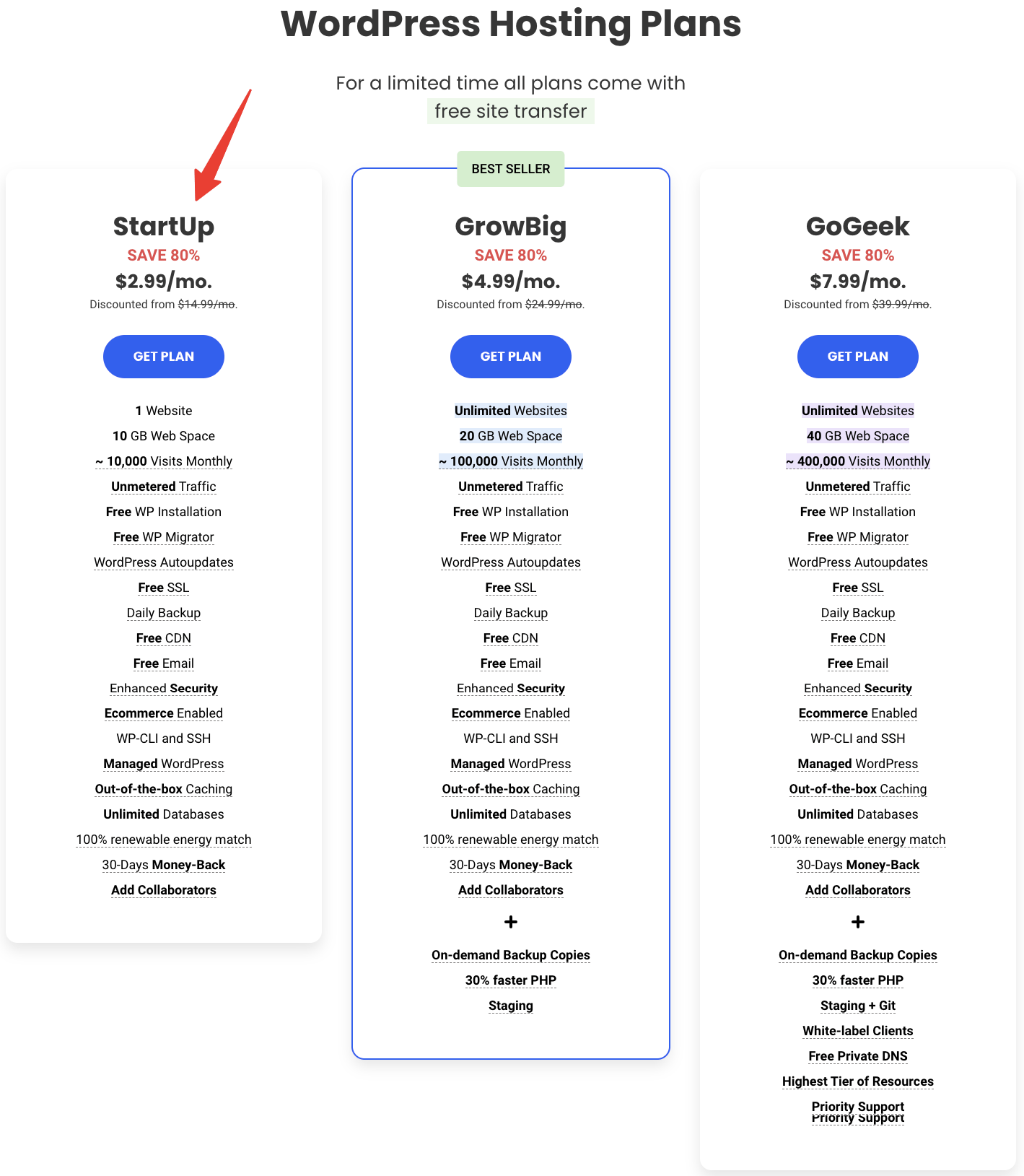
Step 3: Enter your domain name. If you’ve already registered it elsewhere, click I already have a Domain; otherwise, choose Register a New Domain.
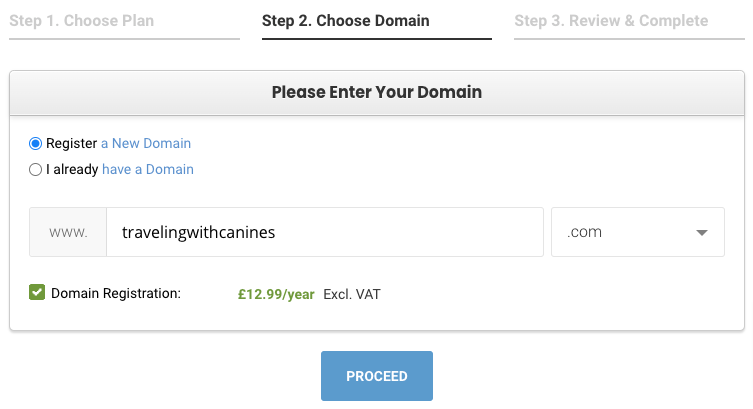
Step 4: Hit Proceed to check your domain name hasn’t been registered by anyone else. As long as it’s still available, you’ll be asked to set up an account, give details about your location, and provide payment information.
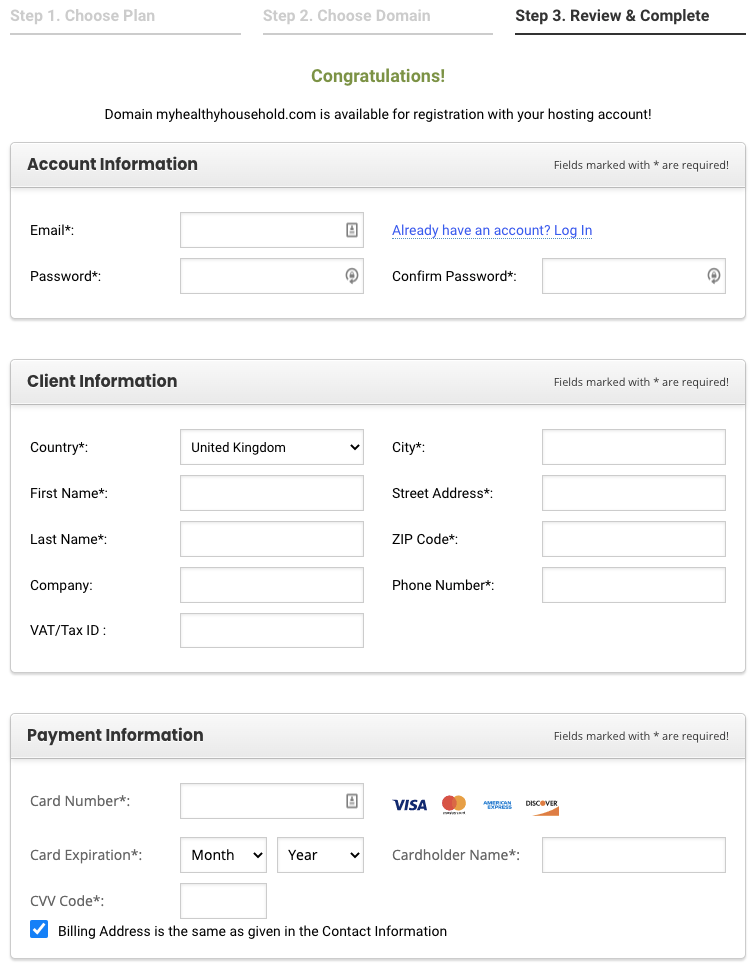
Step 5: Choose the length of your hosting package. At time of writing, the best deal is on the 12-month option.
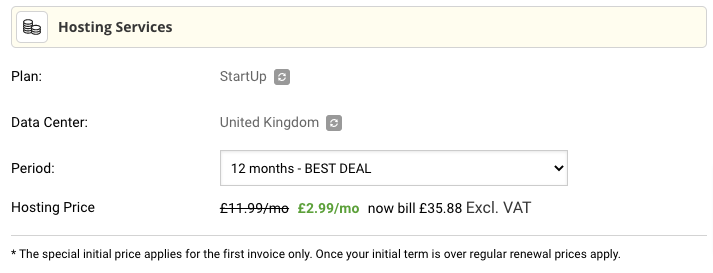
Step 6: Pick out any extra services you need. You’ll need Domain Registration (unless you’ve registered your domain elsewhere), but the others are optional.
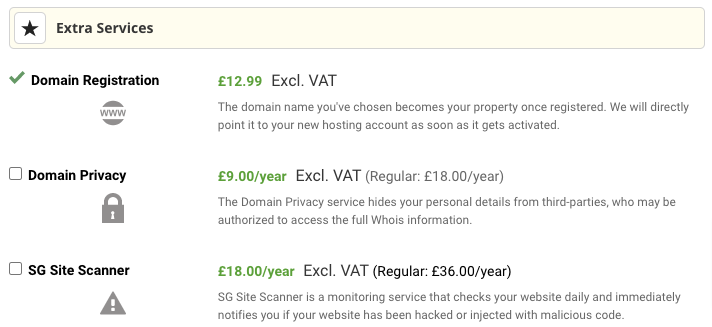
Step 7: Hand over the cash!
5 Choose Your Pet Blog Theme
Your blog theme is the window dressing that sets your pet blog apart from the competition.
Without an attractive theme, people aren’t going to stick around to read your brilliant blog content. And who can blame them? Would you be reading this article if it was published on a plain text website?
When it comes to choosing a theme, you want to pick something that matches your audience’s expectations.
Your competitor research should help you identify what a pet blog is “meant to look like”; it’s probably going to be bright and cheerful and feature lots of pictures of happy-looking pets.
And while there’s something to be said for going against the grain, you definitely don’t want to scare people off.
Okay, so where can you find potential themes for your pet blog?
We’d recommend checking out the following platforms:
Each offers tons of options — including a bunch of free themes — that are perfect for the pet niche.
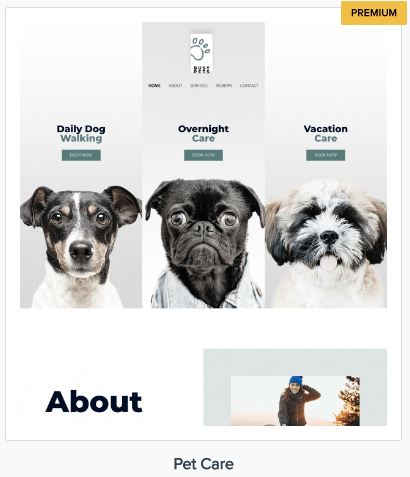
You might assume that premium themes look better and offer a bunch of extra functionality vs. free themes.
To an extent, you’re right: premium themes offer greater scope for customization.
But as far as we’re concerned, a free theme will suit you just fine in early days of your brand new blog (and possibly beyond). If you need more freedom, you can upgrade later on.
Beyond choosing a blog theme that looks good, you’ll also want to make sure it’s:
- Fast
- Responsive
- Well-reviewed
- Customizable
- Got excellent customer support
Once you’ve picked out your favorite theme, you can install it by:
- Logging into your WordPress dashboard
- Clicking Appearance
- Heading to Themes
- Clicking Add New
- Searching for your chosen theme
- Hitting Install

6 Decide On Your Pet Blog Design & Color Palette
You’ll be making more critical branding decisions at this stage.
Specifically, designing your blog logo and picking a color palette.
This stuff can be a little intimidating unless you’re a graphic designer. But fortunately, there are a few free tools that handle most of the complex work for you.
Let’s start with color palette (because there’s no point in creating a logo before you’ve chosen your brand colors).
We use a tool called Coolors, which automatically generates complementary color palettes at the click of a button:
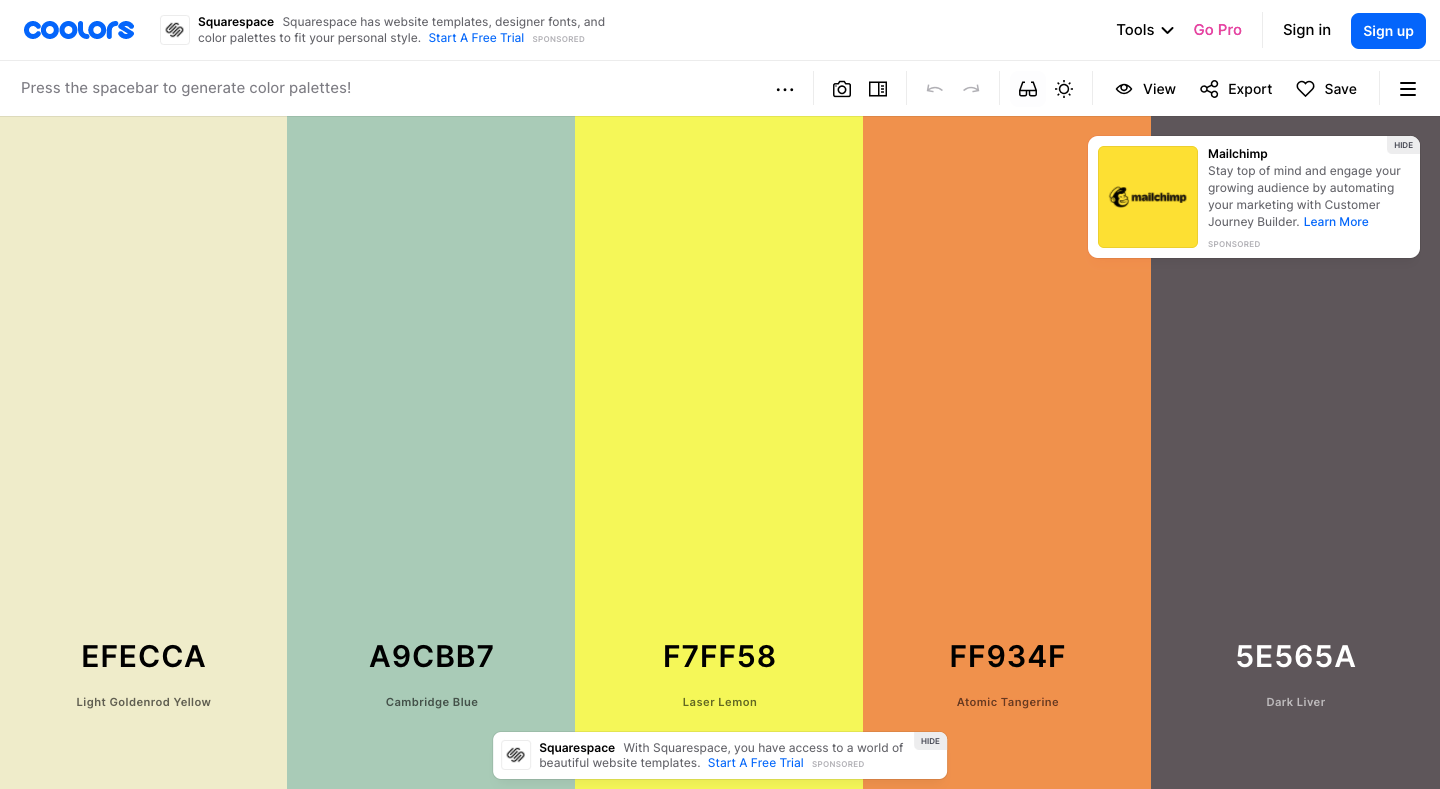
When you’ve found one you like, just take note of the hex codes.
Now for your logo.
For this bit, we definitely recommend using Canva, which has a library featuring hundreds of logo templates:

Again, keep scrolling until you find one that catches your eye, then customize it with your blog name and brand colors.
That wasn’t so difficult, was it?
7 Create Essential Website Pages
By now, you’ve got a theoretically pretty but entirely empty website.
So it’s time to build out your most important web pages:
Homepage
For most people, their first interaction with your pet blog will be your homepage. So it needs to look fantastic, explain your site, and make it easy for people to navigate to deeper pages.
About us page
This is where you tell your story. What made you get started with pet blogging? What pets do you have, and what are their names? What do you love doing with them?
Contact page
Add links to relevant social media profiles, plus a contact form or email address to handle questions from your audience, guest posting requests, and collaboration inquiries.
Privacy policy
This key page explains the information you collect on your audience. We’d recommend using a tool like PrivacyPolicies.com to create yours.
Creating the content for those pages will take a little time, but creating them in WordPress couldn’t be simpler:
- Log in to your WordPress dashboard
- Navigate to Pages
- Click Create New Page
8 Start Creating Pet Blog Content
Presumably, you wanted to start pet blogging in the first place because you enjoy creating pet-themed content.
At this stage, you’re finally going to make it happen!
But, as usual, there’s a little groundwork to lay first.
You shouldn’t dive in and start writing articles until you’ve set your target keywords.
Researching keywords can sound complicated and dull if you’re new to SEO. But it doesn’t have to be either of those things.
And it’s worth the effort, because when you target the right keywords with decent volumes and low competition, you can generate a ton of website traffic from search engines.
So how do you find those juicy, uncompetitive keywords?
You’ve got a couple options.
You can either do all the hard work yourself by Googling broad terms related to your niche and using the Related searches section to find more specific terms…

…or you could get Ahrefs to do all the hard work for you.
We definitely prefer the second option.
Once you’ve logged into Ahrefs, navigate to the Keywords Explorer tool and enter a broad “seed” keyword, like “dog food”. You’re looking for:
- Keywords with low keyword difficulty scores (15 or lower)
- Decent search volume (this varies by niche, but ideally it’ll be at least 100 a month)
- And, if you’re planning to monetize your pet blog through affiliate marketing, you’ll want them to have some sort of commercial search intent (phrases containing words like “best”, “review”, and “vs”)
Our seed keyword spits out lots of potential options, such as:
| Keyword | Keyword difficulty | Search volume |
|---|---|---|
| best dog food for allergies | 13 | 8,300 |
| best dog food for pitbulls | 5 | 4,500 |
| best grain free dog food | 13 | 3,600 |
| best dog food for picky eaters | 12 | 2,000 |
| best small breed dog food | 11 | 1,300 |
Each of those options could be a post in its own right. Seems like we’ve picked a good niche here!
Once you’ve picked out 5 – 10 potential blog post ideas based on the keywords you’ve discovered, follow these best practices to write posts that engage and inform your audience:
Choose one theme for each post. Be strict with yourself. A post on the best dog food for skin allergies shouldn’t start discussing different types of allergies — save that stuff for other posts, then internally link between them.
Define a clear purpose for each post. Similarly, each blog should have a specific purpose; the action you want people to take after reading it. That could be signing up for your newsletter, reading another post, or buying a product (or something else).
Keep your audience at front of mind. Remember who you’re writing for, and think about what they’ll be interested in. If you’re writing for experienced dog owners, you don’t need to spend 500 words explaining what dog food is.
Encourage readers to join the conversation. Pet blogging is about building a community. Ask your audience to give their own opinions and recommendations or leave follow-up questions, in the comments section or on social media.
Show some personality. You’re starting a pet blog, not an academic journal. Don’t be afraid to put yourself in your posts by adding personal anecdotes and examples. It’ll make your content a lot more relatable.
9 Promote Your Pet Blog
After all that hard work, your guest blog deserves to attract as much attention as possible.
Unfortunately, almost 95% of all web pages don’t rank in the top 10 search positions within a year of being detected by Google, so you don’t want to rely on SEO alone.

Give these additional blog promotion strategies a try:
Write guest posts for other sites. Guest posting is about reaching out to sites with audiences who’d be interested in your content, then writing posts for those sites. Not only will it get your name out there, but it’s also great for building backlinks.
Share posts on social media. Every time you write posts, be sure to share them across your social profiles. Also, try seeding them in relevant forums, and on Facebook Groups and subreddits.
Build a mailing list. When someone reads one of your posts, ask if they want to subscribe to your newsletter. That way, whenever you write a new post, you can send it straight to their email inbox.
Pay for search and social ads. Once you’ve started making money from your blog, you can (potentially) generate a bunch more traffic by promoting your site — or individual articles — via search and/or social ads. This can be expensive, though, so it won’t work for every sub-niche.
Make your post dedicated to one purpose. In other words, don’t try to cover too many topics in a single post. If you find yourself veering onto another subject, consider splitting it out into two (or more) posts instead.
How Do Pet Bloggers Make Money
Even if you only see pet blogging as a hobby or side hustle, it’s worth noting that other bloggers are earning decent money from their websites.
Most will make money through one or more of these four tactics:
1. Affiliate Marketing
In our humble opinion, affiliate marketing is far and away the best and smartest way to monetize a blog in any niche.
It’s passive and doesn’t detract from your audience’s experience of visiting your pet blog.
Whether or not monetization is a big goal for your website, it’s pretty much guaranteed that you’ll occasionally write reviews and buying guides recommending helpful products and services you’ve used and enjoyed to other pet owners.
By adding an affiliate link each time you mention those products and services, you’ll earn a cut of each sale you generate. And it doesn’t cost your readers any more than they’d already pay.
Everyone wins!
Many pet product manufacturers and service providers have affiliate programs, but not all are equally good. For our recommendations, check out our guide to the best pet affiliate programs in 2024.
2. Display Advertising
Another way to generate easy passive income from your pet blogging activity is through display advertising.
In a nutshell, this means signing up with one of the big ad networks and allowing them to place adverts on your site.
Google Adsense is the biggest and best-known of those ad networks, but it basically sucks due to the terrible payouts.
Networks like AdThrive and Mediavine are much better to work with, but they’re also a lot more demanding about who’s allowed to join. AdThrive, for instance, demands a minimum of 100,000 monthly page views, so don’t expect them to snap up your brand new pet blog.
Also, it’s worth noting that display ads can look pretty messy. Just look at all these big, ugly ads taking over the screen on the GoPetFriendly site:
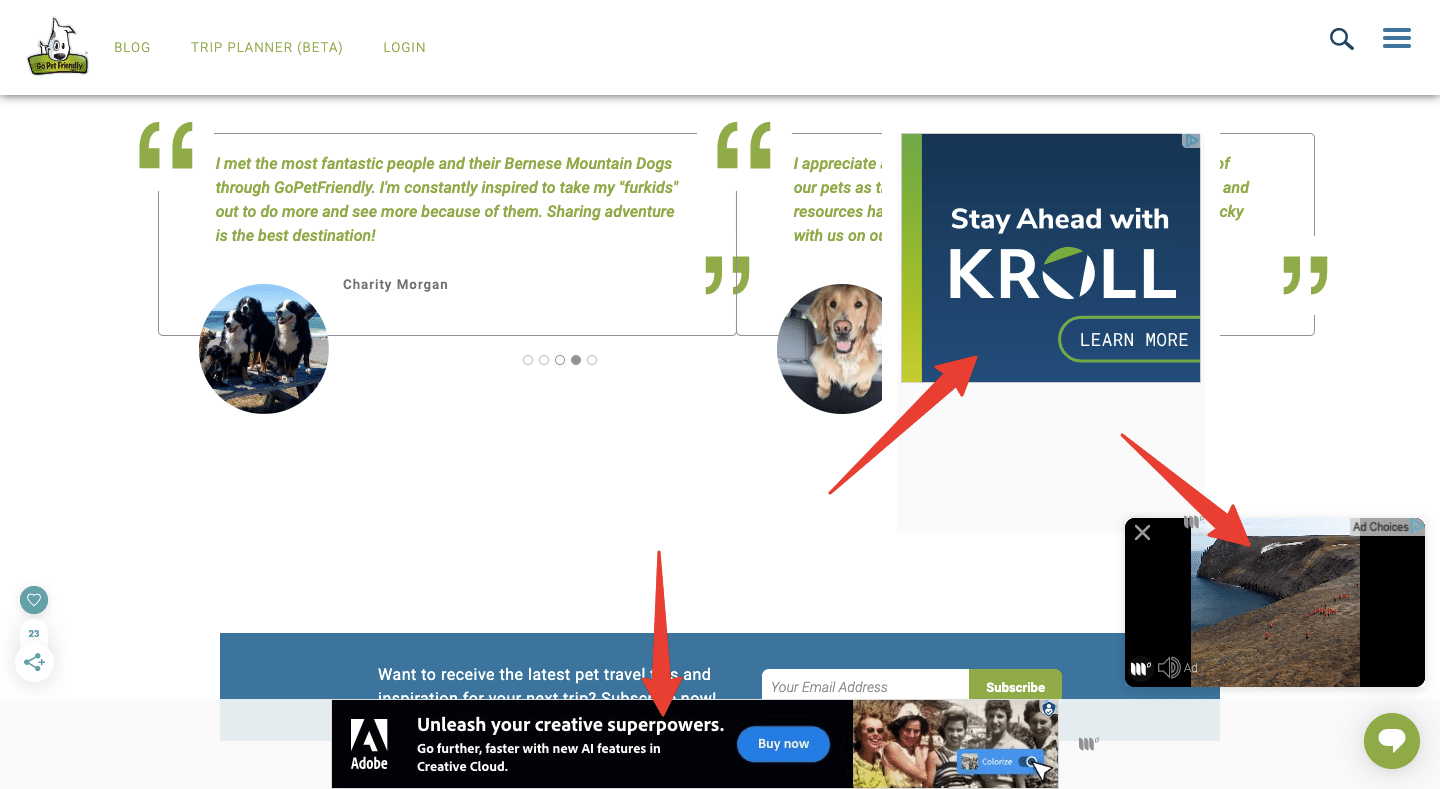
So by taking the display advertising route, you risk putting off some visitors to your site.
3. Sponsorship Deals
Another way to make money through advertising is to secure a sponsorship agreement with one of the myriad pet product manufacturers or service providers.
Typically, this approach will give you much more control over how ads appear on your site, which means less chance of adverts taking over the screen and scaring visitors away.
There’s also scope to earn a lot more money by cutting out the middleman and negotiating your own agreements with advertisers.
On the downside, it’s a bunch more work.
You’ll need to offer tracking, reporting, and analytics, plus a means of processing payments. And if you don’t already have an established audience, it’s hard to imagine any brands being interested.
4. Sell Your Own Products
Typically, products sold by pet bloggers fall into one of two categories:
- Digital products: Things like online courses and downloadable ebooks designed to answer a problem faced by your audience (like litter-training a kitten or teaching a dog to “stay”).
- Services: This basically involves selling your time and expertise. For instance, you might offer a live video consultation on how to train an unruly dog.
If you sell your own products rather than promoting other people’s, you can potentially make more money. Lots more money.
But it’s not easy.
For starters, you’ve got to develop a product that people will pay for.
And you’ve also got to deal with a ton of red tape, from handling payments to dealing with complaints and returns.
It’s the opposite of passive income.
5. Memberships
Some pet bloggers transform their platforms into membership sites that require people to pay a subscription or fixed fee to access premium content or courses.
Again, this is a fantastic way to make money, but it’s not without its pitfalls.
Like selling your own products, you’ll have to deal with all the headachey customer service.
Plus, it’s not feasible for a brand new blog unless you possess real expertise that people can’t find for free anywhere else.
How Much Money Can You Make From Pet Blogging
Let’s be honest: most pet bloggers aren’t earning a ton of money.
According to Indeed, bloggers in the US earn about $45,000 a year. But those figures likely exclude the thousands of bloggers who make little or nothing from their blogs.

On the other hand, Ahrefs data estimates that Dog Food Advisor’s organic traffic is worth a whopping $1.9 million per month.
All that, just from writing a bunch of content about dog food? Sounds good to us!
The important thing is to be realistic.
It’s totally possible to earn a full-time income in the pet blogging world. But you’ll have to put the work in, and it won’t happen overnight.
Anyone who tells you otherwise is lying (and is probably trying to scam you).
What’s Next
So we agree: pet blogging is a totally viable way to make a living, provided you do the hard yards.
Fortunately, we’re here to help with everything from structuring your website to doing keyword research and writing high-quality content.
Just sign up for our free training and we’ll share the seven secrets that make new blogs 83% more successful.
FAQs
Top pet blogs make plenty of money.
According to Ahrefs, Dog Food Advisor — a pet blog that writes exclusively about dog food — generates more than $1.9 million worth of organic traffic every month.
However, that sort of return requires a massive investment in content creation over several years. Most pet bloggers don’t get anywhere near those sorts of earnings.
There are nine main steps to becoming a pet blogger:
1. Choose a pet blogging niche
2. Sign up for a blogging platform
3. Select a name for your blog
4. Buy your domain name and web hosting
5. Choose a theme for your blog
6. Design your logo and choose a color palette
7. Build key web pages (homepage, About Us page, contact page, and privacy policy)
8. Create keyword-focused blog content
9. Promote your blog content
The pet industry can be highly profitable for bloggers.
Pet owners in the US spend hundreds of dollars a year on their pets, and the pet care industry is expected to be worth more than $230 billion by 2030.
As a pet blogger, you’ve got a chance to grab some of that money for yourself.






